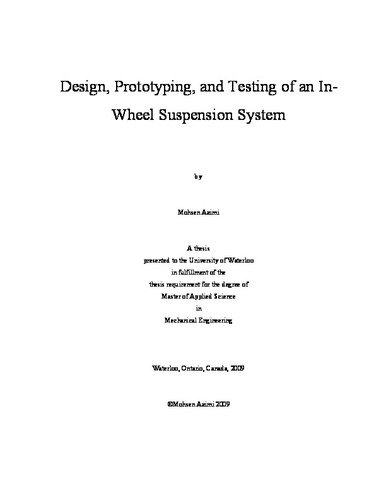| dc.contributor.author | Azimi, Mohsen | |
| dc.date.accessioned | 2009-09-30 18:11:20 (GMT) | |
| dc.date.available | 2009-09-30 18:11:20 (GMT) | |
| dc.date.issued | 2009-09-30T18:11:20Z | |
| dc.date.submitted | 2009 | |
| dc.identifier.uri | http://hdl.handle.net/10012/4748 | |
| dc.description.abstract | This thesis presents a study of a novel suspension system which is placed inside a vehicle's wheel. The In-wheel suspension system isolates the sprung mass from excitations similar to conventional suspension systems. In traditional suspension systems the isolation is provided by spacious and complicated mechanisms, and mainly in the vertical direction. However, the in-wheel suspension system, not only fits the suspension mechanism inside the unused space between a wheel’s rim and hub, but also allows for isolation both in vertical and horizontal directions.
The main focus of this thesis is to study, investigate, and show the feasibility of applying such suspension system to a vehicle. This research is conducted on low speed, low load, and non-powered vehicles such as hand trucks and baby strollers. This helps to escape from the complications of a complex system like a road vehicle. It also demonstrates the versatility of the in-wheel suspension idea. The objective of the project is to scrutinize a simple but practical in-wheel suspension system and demonstrate its applicability.
The research begins with the dynamics modeling of an in-wheel suspension system. This suspension has been previously developed at the University of Waterloo for a wheelchair. The dynamics model evaluates the response of the suspension system and investigates the influence of various design parameters on the in-wheel suspension. The study is then continued to improve the design by replacing its rigid mechanism links with optimized compliant structures. This reduces the system's complexity and weight while boosting its performance. Furthermore, a general optimization code is developed to design and optimize flexible members for in-wheel suspension systems. The optimization program is then used to design and optimize two prototypes for hand trucks. Finally, the in-wheel suspension system for a hand truck is tested and evaluated. The experimental results also verify the simulation results and verify the developed optimization design program. | en |
| dc.language.iso | en | en |
| dc.publisher | University of Waterloo | en |
| dc.subject | In-Wheel Suspension | en |
| dc.subject | Rotating Suspension | en |
| dc.title | Design, Prototyping, and Testing of an In-Wheel Suspension System | en |
| dc.type | Master Thesis | en |
| dc.pending | false | en |
| dc.subject.program | Mechanical Engineering | en |
| uws-etd.degree.department | Mechanical and Mechatronics Engineering | en |
| uws-etd.degree | Master of Applied Science | en |
| uws.typeOfResource | Text | en |
| uws.peerReviewStatus | Unreviewed | en |
| uws.scholarLevel | Graduate | en |

